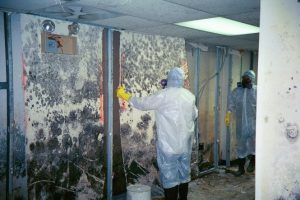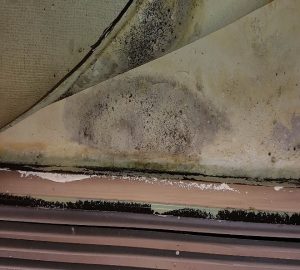What is mold and what causes it? Mold is a type of fungus that is present in our natural environment. Mold spores, which are tiny microscopic ‘seeds’, can be found everywhere, including inside buildings, and are a part of the general dust found in buildings and offices. These spores can start growing on building materials and furnishings if they get wet or stay moist. Mold growth should not be allowed in buildings and offices. Eventually, the mold will damage what it is growing on, which may include both the building and personal belongings. The key to preventing mold growth is to prevent moisture problems and quickly fix and dry any water leaks or spills that might occur.
What is the difference between mold and mildew? Mildew is a type of mold or fungus. A lot of people use this name to describe small black spots of fungus that can start to grow on damp surfaces. If mildew appears, that means there is a moisture problem.
What are the health concerns about mold? Health effects from exposure to mold can vary greatly depending on the person, and the amount of mold in the building. Symptoms that may occur include coughing, wheezing, runny nose and sore throat. People with asthma or mold allergies may notice their asthma or allergy symptoms worsen. Individuals with a severely weakened immune system who are exposed to moldy environments are at risk of developing serious fungal respiratory infections. TDLR recommends that people consult a health care provider if they are concerned about the effects of a moldy environment on their health.
What can be done about indoor mold? Investigate and correct moisture problems and remove mold growth. If mold can be seen or if a musty odor is present, a careful inspection of the building should be conducted. Pay attention to hidden areas, such as plumbing access areas, crawlspaces, behind mirrors and furniture, attics, closets and cupboards.

Correcting a mold problem requires fixing the underlying moisture problem, removing the mold, and keeping the building clean and dry in the future. Mold, generally, can be cleaned from non-porous surfaces such as concrete, metal, glass, tile, and solid wood. However, absorbent (porous) surfaces such as drywall, carpet, fleecy furnishings and insulation are more difficult to clean and often require removal.
Merely applying a chemical such as bleach to drywall, without removing the mold source, is not an effective, permanent solution. Painting over mold is also not effective, even Kilz doesn’t remove mold, it just hides it and often only temporarily. Personal belongings can be kept if there is no mold growth on them. These items may need a deep cleaning to remove mold particles (spores) that have settled in the fabric.
The building owner may want to hire a licensed Mold Consultant company, such as ERC, to determine the extent of a mold problem and to develop a remediation protocol to address it. Under TDLR rules, the remediation of 25 contiguous square feet or more of visible mold in properties with 10 or more units must be conducted by a licensed Mold Remediation Contractor. Small areas of mold growth (less than 25 contiguous square feet) can be cleaned/removed by an owner or by maintenance staff. Please note that testing to determine what kind of mold is present is not required prior to remediation or cleaning. However, to properly measure the effectiveness of a remediation project, testing before and after is highly recommended.
Source: Texas Department of Licensing & Regulation (TDLR)
For more information about molds, visit these sites:
Centers for Disease Control and Prevention (CDC)

